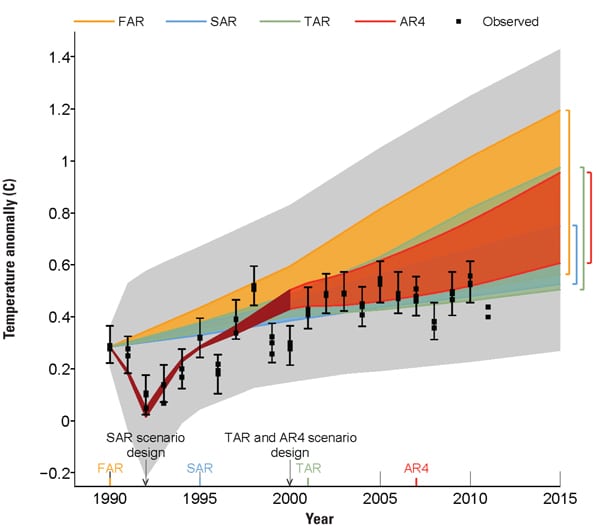Where’s the Warming?
In case you neglected to mark it on your calendar, the Kyoto Protocol to the U.N. Framework Convention on Climate Change (UNFCC) expired at midnight on New Year’s Eve. The 15-year-old treaty was by every account a failure. Global carbon dioxide emissions are up over 50%, yet global temperatures decreased over the same period.
Relying on imprecise computer models to predict nature’s chaotic systems is a fool’s errand. Yet nations are expected to accept and take action on the U.N.’s Intergovernmental Panel on Climate Change’s (IPCC’s) science assessment reports. Preparation of the Fifth Assessment Report (AR5) is under way with the Working Group 1 (WG1) report on the “Scientific Basis” of anthropogenic global warming (AGW) due for release in September.
Facts Supersede Theory
John Adams, our second president, once noted, “Facts are stubborn things; and whatever may be our wishes, our inclinations, or the dictates of our passion, they cannot alter the state of facts and evidence.” I have long believed that given sufficient time, the proponents of AGW will find that “facts and evidence” can no longer be manipulated to match hoped-for theory, particularly with respect to historical and predictive temperature trends. Perhaps the day of reckoning has arrived.
In mid-December, as the delegates to the UNFCC meeting in Doha, Qatar, again failed to reach consensus on a Kyoto Protocol successor or replacement, portions of the 1,000+ pages of the IPCC’s “Second Order Draft” of AR5 were surreptitiously released. The reviewer stated the belief that the public had a right to know the “unedited” report results before IPCC leadership sanitized the final report and its conclusions.
The writers of WG1, for the first time since AR1 was released in 1990, were forced to admit that measured global temperature data does not match their most wishful computer modeling results. Moreover, the myth that AGW is impacting current weather patterns was also soundly debunked. In my opinion, and in the opinion of many scientists who have examined the draft report, the report has the effect of completely undermining the foundation of the IPCC’s pseudo-climate science. Figure 1.4 from the WG1 draft report (below) is illuminating.
 |
In sum, the observational temperature data lies outside (below) the 90% confidence range of its models (model and year published as noted). The colored shading shows the projected range of global annual mean near surface temperatures. The dots within the error bars are the measured temperatures. It’s obvious that the measured temperatures and the temperature trends are lower than the IPCC projections by a wide margin. This figure alone confirms that there has been no statistical warming since 1995, much less the long-predicted AGW.
This conclusion is consistent with the late December UK Met Office Hadley Centre report that the cooling trend will likely continue at least through 2017. Now continue the temperature cooling trend through 2017 to the WG1 figure noted and the conclusion is clear: The IPCC models that have predicted rapid AGW for the past 20+ years cannot be trusted.
As one reviewer of the draft report correctly noted, “When you see experimental data error bars larger than the error bars in the models, you should know that something is really, really wrong.” Despite the 2-sigma error bands, the models dramatically fail to demonstrate that AGW is driving up average global temperatures. Also, I find it inexplicable that so many scientists examined the AR4 data and voted for the “Above the model scenario ranges” option that has unnecessarily perpetuated the hysteria.
Weather Is Not Climate
There were many changes in the draft report related to the effect of expected AGW on weather patterns. Here is a sampling of interesting quotes:
- On extreme weather: “We have high confidence that natural variability dominates any AGW influence in observed/historical TC [tropical cyclones].”
- On droughts: “The current assessment does not support the AR4 conclusions regarding global increasing trends in droughts.”
- On Arctic and Antarctic ice extent: “[The models] simulate decrease in Antarctic sea ice extent compared to slight increases in the observations.” This is a significant reversal from the past “record setting” and “unprecedented” loss of ice noted in past reports.
The IPCC leadership will undoubtedly attempt to sanitize the final report, but the changes will be readily apparent. I expect skillful editing of the final draft, “new and improved” computer models, and revised theories will be cited in a vain attempt to hide the obvious cooling trend, in the face of continued rising concentrations of CO2 in the atmosphere.
Also left out of the final report was the presence of the temperature data “hockey stick” predicted by Dr. Mann and made famous by Al Gore. Its face is pointed down on the left and the handle is sloping down and to the right.
— Dr. Robert Peltier, PE is POWER’s editor-in-chief.